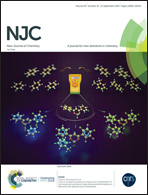An easy-to-synthesize multi-photoresponse smart sensor for rapidly detecting Zn2+ and quantifying Fe3+ based on the enol/keto binding mode†
Abstract
A readily available 4-diethylaminosalicylaldazine-modified fluorene Schiff base (EASA-F) was designed and synthesized through a one-step reaction. EASA-F exhibited a fast fluorescence OFF–ON response to Zn2+ and an OFF–ON–OFF behavior to Fe3+ in aqueous acetonitrile. This was synchronously accompanied by diverse absorption-ratiometric changes and colorimetric changes that were observable by the naked eye; these changes were attributed to the inhibition of C![[double bond, length as m-dash]](https://www.rsc.org/images/entities/char_e001.gif) N isomerization and ESIPT processes in addition to the ICT mechanism that resulted from the different binding modes between the enol–keto species and Zn2+/Fe3+. Moreover, the multi-optical responses of EASA-F to Zn2+/Fe3+ were reversible with EDTA as the chelating ligand. These findings combined with the dual-optical changes from the metal displacement of EASA-F–Zn2+ by Fe3+ make the single-molecule EASA-F a real-time versatile sensor for sensitively detecting Zn2+ and accurately quantifying Fe3+.
N isomerization and ESIPT processes in addition to the ICT mechanism that resulted from the different binding modes between the enol–keto species and Zn2+/Fe3+. Moreover, the multi-optical responses of EASA-F to Zn2+/Fe3+ were reversible with EDTA as the chelating ligand. These findings combined with the dual-optical changes from the metal displacement of EASA-F–Zn2+ by Fe3+ make the single-molecule EASA-F a real-time versatile sensor for sensitively detecting Zn2+ and accurately quantifying Fe3+.



 Please wait while we load your content...
Please wait while we load your content...